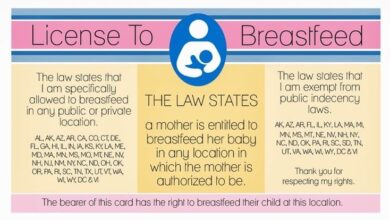
Breast feeding in public – Breastfeeding in public is a complex issue, encompassing historical attitudes, legal frameworks, social perceptions, and the well-being of both mothers and children. This exploration delves into the nuances of breastfeeding in public, from the challenges of societal stigma to the practical considerations of finding discreet and comfortable spaces. We’ll examine diverse perspectives, highlight the benefits for both mother and child, and discuss the role of media and community support in shaping attitudes.
From comparing laws across countries to analyzing media portrayals, this discussion offers a comprehensive overview of the realities surrounding breastfeeding in public spaces. Understanding the interplay between societal norms, personal experiences, and practical solutions is crucial for fostering a more supportive environment for breastfeeding mothers.
Public vs. Private Breastfeeding Spaces
Breastfeeding, a fundamental act of nourishment and bonding, has been a subject of evolving societal attitudes and legal considerations. While once largely relegated to private spaces, it has increasingly become a topic of public discourse, with varying degrees of acceptance and regulation around the world. This exploration delves into the historical context, legal frameworks, and cultural nuances surrounding breastfeeding in public spaces, examining the arguments for and against this practice in different environments.Societal attitudes towards breastfeeding in public have undergone a significant transformation.
Historically, breastfeeding was often perceived as a private act, with women frequently discouraged from expressing their bodies openly in public. This perception stemmed from a combination of cultural norms, religious beliefs, and societal expectations of modesty. However, this view has been gradually challenged over time, with growing awareness and advocacy for the rights and needs of breastfeeding mothers.
Historical Overview of Societal Attitudes
Breastfeeding in public was largely taboo in many societies for centuries, often viewed as indecent or inappropriate. This stemmed from Victorian-era ideals of modesty and a general lack of understanding of the physiological process of breastfeeding. Public displays of affection, including nursing, were discouraged. This view slowly began to shift in the mid-20th century as medical professionals began to emphasize the importance of breastfeeding for infant health.
Comparison of Laws and Regulations Across Countries
The legal landscape surrounding breastfeeding in public varies significantly across different countries. Some jurisdictions have enacted specific laws or regulations that explicitly protect breastfeeding mothers’ rights, while others rely on general public decency laws. Cultural norms play a significant role in shaping these regulations, with some cultures more accepting of breastfeeding in public than others.
Examples of Public Spaces Designed to Accommodate Breastfeeding Mothers
Several public spaces have made efforts to accommodate breastfeeding mothers. These accommodations often include designated nursing rooms, quiet corners, or simply providing a degree of privacy. For example, many modern airports have designated nursing areas with comfortable seating and privacy screens. Some restaurants are also becoming more accommodating, with options like private booths or secluded corners. Furthermore, certain cafes and community spaces offer breastfeeding-friendly zones.
Cultural Norms Surrounding Breastfeeding
Cultural norms play a crucial role in shaping the acceptability of breastfeeding in public. In some cultures, breastfeeding in public is a common and accepted practice, viewed as a natural and healthy part of parenting. In other cultures, breastfeeding in public may be viewed as inappropriate or even offensive. This variation highlights the diverse ways that different societies perceive and value the act of breastfeeding.
Arguments for and Against Breastfeeding in Public Spaces
Arguments for breastfeeding in public often center on the practical benefits for mothers and infants. The act of breastfeeding provides immediate nourishment, supporting infant health and development. Public breastfeeding can foster a sense of community and normalize this essential practice. Arguments against breastfeeding in public often cite concerns about public discomfort or societal norms. Some individuals may find the act visually or emotionally upsetting, and this perception can create a negative experience for both the breastfeeding mother and those around her.
Comparison of Laws/Regulations in Three Different Countries
| Country | Breastfeeding Laws/Regulations | Notable Considerations |
|---|---|---|
| United States | No federal law explicitly protects breastfeeding in public. States have varying laws. | While no federal law exists, some states have laws or regulations that protect breastfeeding mothers’ rights, often citing public health benefits. |
| Canada | No specific federal law, but provinces/territories have regulations. Often, general public decency laws are applied. | Provincial/territorial laws vary, but generally aim to balance the mother’s right to breastfeed with the public’s comfort. |
| United Kingdom | No specific federal law, but some local authorities have policies that support breastfeeding mothers. Public decency laws are often used. | Regulations are often based on local policies rather than a uniform national law, reflecting varying cultural norms. |
Social Perceptions and Stigma: Breast Feeding In Public

Breastfeeding in public, though a natural and healthy act, often faces societal judgment and stigma. These negative perceptions stem from a combination of cultural norms, misinformation, and ingrained prejudices. This can significantly impact the emotional well-being and experience of breastfeeding mothers. Addressing these stigmas requires a multifaceted approach that acknowledges the root causes and promotes understanding.Common stereotypes surrounding breastfeeding in public include perceptions of it as being inappropriate, unhygienic, or overly demanding.
These stereotypes often stem from a lack of awareness and understanding about the physiological aspects of breastfeeding and the needs of nursing mothers. This lack of awareness leads to judgment and negative reactions, creating a challenging environment for breastfeeding mothers.
Common Stereotypes and Prejudices
Many individuals harbor misconceptions about breastfeeding, often influenced by cultural norms or outdated beliefs. These misconceptions can manifest as judgmental stares, whispered comments, or outright criticism. The fear of judgment can deter mothers from breastfeeding in public, limiting their ability to nourish their infants in a comfortable and accessible environment. It is important to acknowledge that these stereotypes are often unfounded and stem from a lack of knowledge and understanding.
Impact of Social Stigma on Breastfeeding Mothers
Social stigma significantly impacts breastfeeding mothers. The constant fear of judgment and negative reactions can lead to feelings of shame, anxiety, and isolation. This emotional burden can negatively affect a mother’s mental health and confidence, impacting her ability to bond with her child and engage in other aspects of her life. Mothers may avoid public spaces or restrict their activities to prevent potential negative encounters, which limits their freedom and quality of life.
Examples of Public Shaming or Negative Reactions
Instances of public shaming or negative reactions towards breastfeeding mothers are unfortunately common. These can range from disapproving stares and hushed conversations to outright hostility and demands to cover up. For example, some mothers have reported being asked to leave public spaces or restaurants due to their choice to breastfeed. In other cases, mothers have faced verbal abuse or judgmental comments from strangers.
These negative experiences create a hostile environment for breastfeeding mothers, undermining their confidence and well-being.
Psychological and Emotional Distress
The negative experiences of breastfeeding mothers in public can lead to significant psychological and emotional distress. Feelings of shame, embarrassment, and anxiety are common, potentially impacting a mother’s self-esteem and overall mental health. The constant fear of judgment can lead to feelings of isolation and difficulty in bonding with their infant. This distress can have long-term consequences for both the mother and child.
Methods for Addressing Social Stigmas
Various methods can be employed to address social stigmas surrounding breastfeeding in public. These include public awareness campaigns, education programs, and the creation of more inclusive and supportive environments. Legislation that protects breastfeeding mothers’ rights in public spaces can also help to reduce negative experiences. Promoting positive role models and encouraging open dialogue can help to normalize breastfeeding in public.
Summary of Negative Reactions
| Type of Negative Reaction | Frequency (Estimated) |
|---|---|
| Disapproving stares/whispers | High |
| Verbal criticism/comments | Medium |
| Demands to cover up | Medium |
| Exclusion from public spaces | Low |
| Physical harassment/abuse | Very low |
Note: This table provides a general estimate of the frequency of different negative reactions. Exact data is difficult to collect due to the subjective nature of these experiences and the lack of comprehensive reporting systems.
Public breastfeeding can be tricky, navigating judgmental stares and awkward silences. But, there’s a parallel struggle, one that’s often overlooked, relating to the emotional toll of traumatic brain injuries. Thankfully, relief ahead for traumatic brain injuries is becoming increasingly accessible relief ahead for traumatic brain injuries , just like increased acceptance for breastfeeding mothers. Ultimately, both deserve understanding and support, and it’s time we normalize both.
Maternal and Child Well-being
Breastfeeding, a natural and vital process, profoundly impacts both the mother and the child. It provides numerous benefits for their health, development, and overall well-being. Understanding these benefits, and the importance of supporting mothers who choose to breastfeed in public, is crucial for fostering a supportive and inclusive environment.Breastfeeding offers a unique and powerful bond between mother and child, fostering physical and emotional closeness.
This closeness is not just anecdotal; studies show it strengthens the immune system, and helps the child develop cognitive skills.
Benefits of Breastfeeding for Mothers
Breastfeeding offers numerous physical and emotional advantages for mothers. The hormonal changes associated with breastfeeding, including the release of oxytocin, contribute to a feeling of well-being and bonding. Furthermore, breastfeeding can aid in postpartum recovery by helping the uterus return to its normal size more quickly. The nutritional and caloric intake from breastfeeding also plays a role in weight management.
A mother who breastfeeds may experience reduced risk of certain cancers, like ovarian and breast cancer, later in life.
Benefits of Breastfeeding for Children
Breast milk provides an ideal nutritional source for infants, containing antibodies and nutrients that promote a robust immune system and help prevent illnesses. The consistent supply of essential nutrients throughout the first years of life supports healthy development and cognitive function. Furthermore, breastfed infants have a lower risk of developing allergies, respiratory illnesses, and obesity later in life.
This is evidenced by extensive research and long-term studies.
Importance of Comfort and Support
Mothers who feel comfortable and supported when breastfeeding in public are more likely to continue breastfeeding. A lack of support or judgment can negatively impact their confidence and self-esteem, potentially affecting their breastfeeding journey. This support includes not just the absence of negative reactions, but also positive affirmations from others, and a clear understanding of breastfeeding’s benefits.
Potential Impact of Pressure to Hide Breastfeeding
When mothers feel pressured to hide or avoid breastfeeding in public, it can have a detrimental impact on their child’s development. A mother who feels judged or uncomfortable is less likely to breastfeed, potentially depriving her child of the crucial nutrients and antibodies provided by breast milk. This can have lasting implications for the child’s health and well-being.
Impact on Maternal Confidence and Self-Esteem
Public breastfeeding can significantly affect a mother’s sense of confidence and self-esteem. When mothers feel comfortable expressing their choice to breastfeed in public, it can empower them. Conversely, feeling judged or stigmatized can lead to feelings of shame and self-consciousness, impacting their self-esteem.
Benefits of Supporting Public Breastfeeding
Supporting mothers who choose to breastfeed in public fosters a more inclusive and supportive society. It promotes understanding, respects the natural act of breastfeeding, and ensures mothers feel empowered to provide the best possible care for their children. This support is crucial to the long-term health of both mother and child.
Short-Term and Long-Term Benefits of Breastfeeding
| Benefit Category | Short-Term Benefits | Long-Term Benefits |
|---|---|---|
| Immune System | Reduces risk of infections like ear infections, respiratory illnesses, and diarrhea. | Reduces risk of allergies, asthma, and other chronic diseases. |
| Nutritional Value | Provides optimal nutrition tailored to the infant’s needs. | Supports healthy growth and development. |
| Cognitive Development | Contributes to brain development and cognitive function. | May lead to better academic performance and improved cognitive skills. |
| Maternal Health | Reduces risk of postpartum bleeding and certain cancers. | Improves long-term health and well-being. |
| Bonding | Fosters a strong emotional bond between mother and child. | Strengthens the mother-child relationship throughout childhood. |
Practical Considerations and Solutions
Breastfeeding in public can be a delicate balancing act between nourishing a baby and navigating societal expectations. This requires understanding the practical steps for discreet and comfortable feeding, as well as advocating for inclusive spaces. Creating supportive environments for breastfeeding mothers is crucial for their well-being and the health of their babies.This section delves into the practical aspects of breastfeeding in public, offering solutions to ensure comfort, privacy, and a positive experience for all involved.
It explores strategies for discreet feeding, accessible spaces, and the design principles behind inclusive environments. Ultimately, the aim is to foster a culture of acceptance and support for breastfeeding mothers everywhere.
Discreet Breastfeeding Methods
Breastfeeding discreetly in public requires thoughtful planning and consideration of the environment. A strategically placed nursing cover or wrap can provide a degree of privacy without drawing undue attention. Choosing clothing that allows for easy access to the breast is also key. Light layers or nursing-friendly tops can offer flexibility and support during feeding.
Accessible and Comfortable Breastfeeding Spaces
The provision of designated and comfortable breastfeeding spaces is paramount. These spaces should be readily available, well-lit, and equipped with comfortable seating, a changing table, and a sink for cleaning. The design of these spaces should prioritize privacy and minimize potential distractions. The provision of these spaces reduces stress and promotes the continuation of breastfeeding for mothers and infants.
Design Principles for Inclusive Spaces
Inclusive breastfeeding spaces should be designed with the needs of both mothers and infants in mind. Good ventilation, comfortable seating, and adequate lighting are crucial components. The spaces should be easily accessible, ideally located near public restrooms, and have discreet entrances and exits. Visual cues like subtle signage or strategically placed artwork can direct individuals to designated spaces.
Furthermore, clear and visible signage indicating the location of these spaces is essential.
Public breastfeeding can be a tricky subject, fraught with societal pressures and judgments. While it’s a completely natural act, it’s not always easy to navigate the sometimes awkward situations that arise. This brings me to a related, yet seemingly disparate, issue: is the rheumatology field running out of doctors? is the rheumatology field running out of doctors.
Perhaps the shortage of specialists in fields like rheumatology, impacting the availability of care, highlights a broader issue about societal acceptance and support for parents who choose to breastfeed. Ultimately, creating a more supportive and understanding environment for breastfeeding mothers in public is crucial.
Practical Tips for Navigating Public Breastfeeding Situations
Navigating public breastfeeding situations requires a blend of confidence and preparedness. Mothers should choose locations with potential for privacy, and anticipate potential discomfort from onlookers. Practicing positive self-talk and reminding oneself of the importance of feeding the baby can help manage potential negative reactions. If encountered with negativity, maintaining a calm demeanor and politely asserting the need for privacy is key.
Public breastfeeding can sometimes feel tricky, especially during the holidays when you’re juggling lots of activities and potentially more germs. Think about how you can minimize the spread of nasty bacteria around the house during the holidays – how to avoid dangerous baceria in your home during the holidays – and you can feel more confident about nursing your little one in public spaces.
It’s all about being prepared and knowing your options.
This proactive approach can create a more supportive atmosphere.
- Choose locations with potential for privacy, like a quiet corner in a café or a designated breastfeeding area.
- Inform yourself about local policies and laws regarding breastfeeding in public.
- Dress in comfortable clothing that allows for easy access to the breast.
- Carry a nursing cover or wrap for added discretion.
- Practice positive self-talk to manage potential discomfort from onlookers.
Comparing Solutions for Privacy and Comfort
Various solutions exist to provide privacy and comfort in public areas. Nursing covers offer a degree of discretion and can be used in diverse settings. Designated breastfeeding spaces are a more permanent solution and provide a sense of security. Private rooms or designated areas within restaurants, cafes, or other public places can offer the most comprehensive level of privacy.
Choosing the right solution depends on the specific context and the mother’s comfort level.
Practical Tips for Breastfeeding in Different Public Spaces
| Public Space | Practical Tip |
|---|---|
| Restaurants/Cafes | Choose a quieter corner, request a table away from the main area, or use a nursing cover. |
| Parks | Select a secluded area with shade and privacy. |
| Shopping Malls | Look for designated breastfeeding areas or a quiet room. |
| Public Transportation | If possible, choose a less crowded seat or find a discreet location. |
Media Representation and Public Awareness

Media plays a powerful role in shaping public perception of breastfeeding. From subtle portrayals to overt depictions, the way breastfeeding is shown in movies, television, and online platforms significantly influences how society views this natural act. Understanding these representations is crucial to fostering a more supportive and accepting environment for breastfeeding mothers.Media portrayals can either reinforce existing societal norms or challenge them.
The presence or absence of breastfeeding scenes, the context in which they appear, and the attitudes displayed by characters all contribute to the overall message conveyed. This analysis aims to shed light on how media can be a catalyst for change in public attitudes towards breastfeeding.
Examples of Media Representations
Media representations of breastfeeding range from absent to actively promoting it. Some shows and films might entirely avoid the topic, perpetuating a sense of invisibility for breastfeeding mothers. Others might show fleeting or awkward portrayals, reinforcing negative stereotypes. Conversely, some productions portray breastfeeding as a normal and natural part of motherhood, highlighting its importance and the bond between mother and child.
Analysis of Media Influence on Public Perception
Media representations can either positively or negatively influence public perception of breastfeeding in public. For instance, a frequent depiction of mothers discreetly breastfeeding in private reinforces the notion that it is something to be hidden. Conversely, scenes showing open and comfortable breastfeeding can challenge this stigma and promote acceptance.
Role of Media in Promoting Positive Attitudes
Media has the potential to play a significant role in promoting positive attitudes toward breastfeeding. By showcasing breastfeeding in diverse settings, featuring a variety of mothers, and portraying it as a normal and healthy activity, media can significantly shift public perception. The media can promote understanding by emphasizing the benefits for both mother and child.
Comparison of Media Portrayals
| Media Representation | Context | Mother’s Attitude | Child’s Attitude | Public Perception Implied |
|---|---|---|---|---|
| Hidden/Awkward | Private, rushed, or uncomfortable | Self-conscious, embarrassed | Uncomfortable or distressed | Breastfeeding is something to be avoided in public |
| Open/Normal | Public place, relaxed, confident | Confident, comfortable | Calm and content | Breastfeeding is a normal, healthy part of parenting |
| Absent/Ignored | No scenes depicting breastfeeding | Non-existent | Non-existent | Breastfeeding is not a significant aspect of motherhood |
Strategies for Improving Media Representation
To improve media representations, filmmakers and producers should actively include breastfeeding scenes in a realistic and positive light. This includes portraying breastfeeding mothers in diverse settings, ethnicities, and body types. Further, showing the ease and comfort of breastfeeding can help break down misconceptions and promote understanding. This approach can significantly impact public perception.
Significance of Media in Shaping Social Norms, Breast feeding in public
Media has a profound impact on shaping social norms and perceptions. Consistent and positive depictions of breastfeeding in various media outlets can shift public opinion and create a more supportive environment for breastfeeding mothers. Positive representations can counteract negative stereotypes and foster acceptance, paving the way for a more inclusive society. Media has a strong influence on public opinion, and this influence is particularly evident in sensitive issues like breastfeeding in public.
Community Support and Advocacy
Breastfeeding, a deeply personal journey, benefits both mother and child immensely. However, navigating the complexities of public perception, practical challenges, and societal expectations can be isolating. A strong community network plays a vital role in empowering breastfeeding mothers and fostering a supportive environment. This support extends beyond immediate family and encompasses a broader network of individuals, organizations, and resources.A supportive community acts as a safety net, providing practical assistance, emotional encouragement, and a sense of belonging.
It’s more than just advice; it’s a shared experience that fosters confidence and reduces the stress often associated with breastfeeding. This network is crucial for mothers to feel understood and empowered in their decision to breastfeed.
Importance of Community Support
Breastfeeding mothers often face unique challenges, including social stigma, practical difficulties, and concerns about their own well-being. A robust community network offers invaluable support through shared experiences, advice, and a sense of shared understanding. Mothers are less likely to feel alone in their journey, fostering greater confidence and enabling them to overcome hurdles more effectively.
Effective Strategies for Building a Supportive Community
Building a supportive community involves proactive efforts to connect and encourage mothers. Workshops and seminars provide educational resources and opportunities for mothers to connect with others. Peer support groups facilitate discussions and sharing of experiences, enabling mothers to learn from one another’s successes and challenges. Community centers and local organizations can host breastfeeding-friendly events and resources, further strengthening the network.
Examples of Successful Advocacy Campaigns
Numerous advocacy campaigns have successfully promoted breastfeeding through awareness campaigns and policy changes. These campaigns often involve public education initiatives, collaborations with healthcare providers, and community outreach programs. For example, campaigns highlighting the benefits of breastfeeding for both mothers and children have led to increased public awareness and support. These efforts have effectively challenged societal stigma and promoted breastfeeding as a positive choice.
Role of Breastfeeding Support Groups and Organizations
Breastfeeding support groups and organizations play a crucial role in providing education, resources, and emotional support to mothers. These groups offer a safe space for mothers to connect with others facing similar challenges and celebrate successes together. They provide valuable information on breastfeeding techniques, common problems, and solutions. Organizations also advocate for policies that support breastfeeding mothers, working to create a more inclusive and supportive environment.
Ways to Support Breastfeeding Mothers
- Offer practical assistance, such as childcare or household help.
- Provide emotional support through encouragement and understanding.
- Share resources about breastfeeding support groups and organizations.
- Educate yourself on the benefits of breastfeeding and common challenges.
- Advocate for policies that support breastfeeding mothers.
A supportive network can make a significant difference in a breastfeeding mother’s experience. By understanding the challenges and providing practical support, we can foster a more inclusive environment that encourages and empowers mothers.
Resources for Breastfeeding Mothers and Support Organizations
| Organization | Website/Contact Information |
|---|---|
| La Leche League International | www.llli.org |
| International Lactation Consultant Association (ILCA) | www.ilca.org |
| Human Milk Banking Association of North America (HMBANA) | www.hmbana.org |
| Local Lactation Consultants | Search online for lactation consultants in your area. |
| Local Hospitals/Clinics | Contact your local hospitals or clinics for support groups and resources. |
These resources provide valuable information, support, and guidance for breastfeeding mothers. Utilizing these resources can enhance the breastfeeding experience and promote maternal and child well-being.
Conclusive Thoughts
Ultimately, fostering a supportive environment for breastfeeding mothers in public requires a multifaceted approach. This includes advocating for better public policies, challenging social stigmas, and promoting positive media representations. By understanding the historical context, societal perceptions, and practical considerations, we can move towards a future where breastfeeding mothers feel comfortable and supported in all public spaces. This conversation highlights the importance of creating a culture of acceptance and understanding, ensuring that mothers feel empowered and confident in their choice to breastfeed wherever they are.





